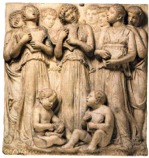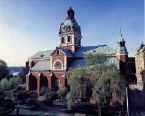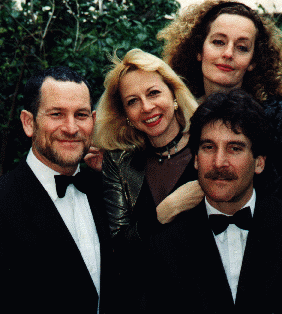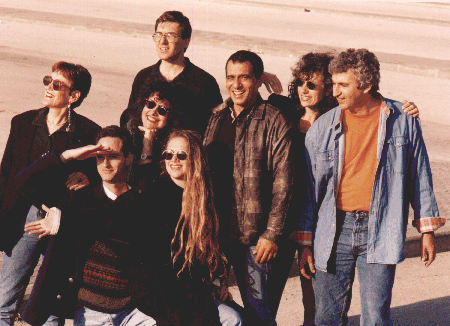 The Opera
The Opera
 Vocal Jokes
Vocal Jokes
 Quotations
Quotations
 Notes
Notes
 Dictionary
Dictionary
|
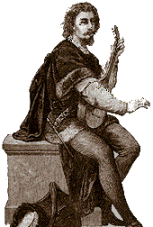 The
human voice
Man's voice has been used by him, for making music, ever
since he became human. Self-expression through singing
is the earliest form of music humans have experienced.
The human voice allows a person to sing, and its compound
of harmonics The
human voice
Man's voice has been used by him, for making music, ever
since he became human. Self-expression through singing
is the earliest form of music humans have experienced.
The human voice allows a person to sing, and its compound
of harmonics (overtones) is the one providing it with its vocal uniqueness. The human
voice can be improved by practice and exercise called vocal training.
Human voices are sorted into six
kinds, by their pitch (see voice chart
(overtones) is the one providing it with its vocal uniqueness. The human
voice can be improved by practice and exercise called vocal training.
Human voices are sorted into six
kinds, by their pitch (see voice chart ).
In addition, there is another classification of voices, by quality and
nature. Thus, we find a dramatic soprano (a strong voice fit for
recitation and theatre), a lyric voice (light and pleasant), and
so on.
The choir ).
In addition, there is another classification of voices, by quality and
nature. Thus, we find a dramatic soprano (a strong voice fit for
recitation and theatre), a lyric voice (light and pleasant), and
so on.
The choir is the vocal ensemble, and it includes the four main groups: soprano
is the vocal ensemble, and it includes the four main groups: soprano  ,
alto ,
alto ,
tenor ,
tenor and bass
and bass .
Choir .
Choir sometimes sing a cappella
sometimes sing a cappella ,
meaning without the accompaniment of an instrument or an orchestra. ,
meaning without the accompaniment of an instrument or an orchestra.
The History of art singing
 Until
the 9th century, singing was monophonic Until
the 9th century, singing was monophonic .
From the year 860 a.d. and on, people started singing in two parallel voices
(this is the famous organum .
From the year 860 a.d. and on, people started singing in two parallel voices
(this is the famous organum ),
and in the 12th century, French composer Pérotin ),
and in the 12th century, French composer Pérotin began writing arrangements for four separate voices, in polyphony
began writing arrangements for four separate voices, in polyphony .
This is the stage when singers started gaining their own place as respectable
musicians. Polyphony evolved further and further, until the 16th century,
as Thomas Tallis .
This is the stage when singers started gaining their own place as respectable
musicians. Polyphony evolved further and further, until the 16th century,
as Thomas Tallis wrote a motet for 40 different voices.
In the middle ages
wrote a motet for 40 different voices.
In the middle ages ,
many singers became revered and some of them were also important composers.
Dufay ,
many singers became revered and some of them were also important composers.
Dufay ,
Josquin des Préz ,
Josquin des Préz ,
Ockeghem ,
Ockeghem and others are considered to be the most important composers of
the era, mostly for their masses
and others are considered to be the most important composers of
the era, mostly for their masses  and motets
and motets .
The 16th century brought about the blossom of madrigal .
The 16th century brought about the blossom of madrigal - the secular polyphonic song.
- the secular polyphonic song.
 In
the 17th century, the opera In
the 17th century, the opera appeared. This is the most prominent combination of soloist singers'
voices, choir singing and instrumental accompaniment - all matched with
theatrical playing and drama, stage design and other effects. Its greatest
artists were Gluck
appeared. This is the most prominent combination of soloist singers'
voices, choir singing and instrumental accompaniment - all matched with
theatrical playing and drama, stage design and other effects. Its greatest
artists were Gluck ("Orpheo et Euridice"), Verdi
("Orpheo et Euridice"), Verdi ("Othelo", "The
Force of Destiny" ("La
forza del destino"), "La
Traviata"
("Othelo", "The
Force of Destiny" ("La
forza del destino"), "La
Traviata" and more), and Mozart
and more), and Mozart ("Don Giovanni", "The
Magic Flute"
("Don Giovanni", "The
Magic Flute" ("Die Zauberflöte"), "The
Marriage of Figaro" ("La Noza di Figgaro")).
Opera's religious counterpart, the oratorio
("Die Zauberflöte"), "The
Marriage of Figaro" ("La Noza di Figgaro")).
Opera's religious counterpart, the oratorio ,
evolves side by side with it, and the predominant composer in this field
is Handel ,
evolves side by side with it, and the predominant composer in this field
is Handel ,
with oratorios such as "Messiah"
and "Jephteh".
As instrumental forms such as the sonata ,
with oratorios such as "Messiah"
and "Jephteh".
As instrumental forms such as the sonata ,
toccata ,
toccata and others evolve, vocal music developed, throughout history, with
the encouragement of the church, on the one hand, and in the secular arena,
by folk singers (troubadours, minesingers and trouvers, according to their
country). In his cantatas
and others evolve, vocal music developed, throughout history, with
the encouragement of the church, on the one hand, and in the secular arena,
by folk singers (troubadours, minesingers and trouvers, according to their
country). In his cantatas (for example, Cantata No. 147 "Jesus,
Joy of Man's Desiring" and Cantata No.
208 "Sheep May Safely Graze"
(for example, Cantata No. 147 "Jesus,
Joy of Man's Desiring" and Cantata No.
208 "Sheep May Safely Graze" ),
Bach ),
Bach elevated the human voice to heights of sanctity and charm; Beethoven
elevated the human voice to heights of sanctity and charm; Beethoven introduced choir and solo singing into the holy of holies of instrumental
music - the symphony, in his 9th Symphony
introduced choir and solo singing into the holy of holies of instrumental
music - the symphony, in his 9th Symphony .
Schubert .
Schubert raised the German lied
raised the German lied (song) to its peak, in his wonderful song cycles - "The
Winter Journey" ("Winterreise"),
and his earlier "The Beautiful Miller"
("Die schöne Mülllerin").
(song) to its peak, in his wonderful song cycles - "The
Winter Journey" ("Winterreise"),
and his earlier "The Beautiful Miller"
("Die schöne Mülllerin").
|
